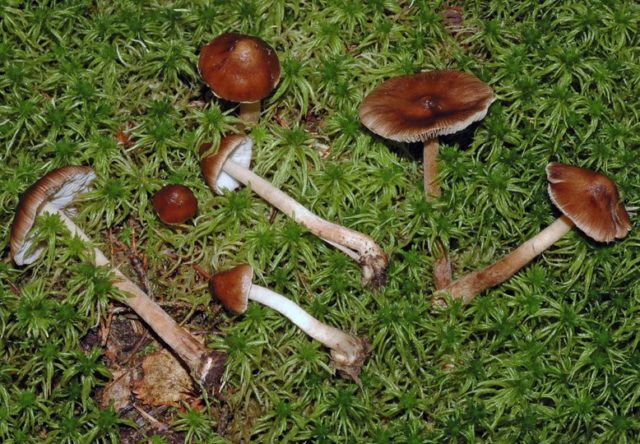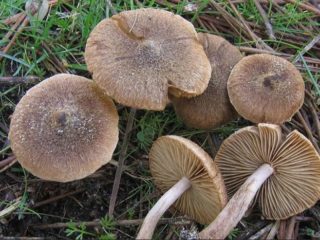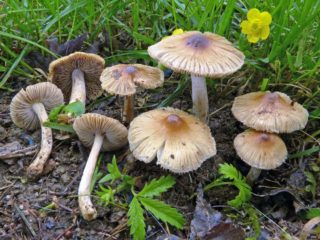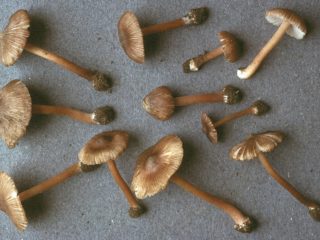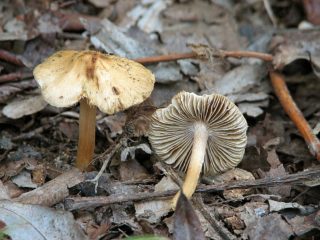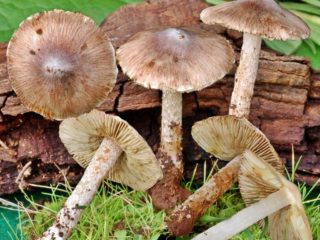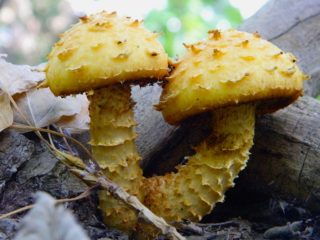Content
Fiberwort (Inocybe napipes) is a poisonous mushroom that has many times more muscarine than fly agaric. The danger lies in the fact that it grows close to edible specimens, and at a young age is very similar to some of them. Other names are turnip-footed fiber or turnip-footed fiber.
What does onion fiber look like?
Fiberwort belongs to the lamellar mushrooms of the Fiberaceae family. The hat at a young age is in the form of a bell, later it opens. There is a bump on the surface. The skin is smooth at first, but as it matures it becomes fibrous and cracks. The diameter of the cap is from 3 to 6 cm.It is painted in a brown-brown shade. The plates of the fruiting body are white at first, then become gray. They are pressed tightly to the leg.
The stem of the onion fiber is cylindrical, its height reaches 8 cm. The upper part is thinned, it widens downward. The color of the leg is identical to the cap, but a little lighter.
The pulp is practically odorless, light, often white or cream. The spores are brown.
Where does onion fiber grow?
The mycelium settles in damp forests, preferring birch groves or other deciduous areas. Fiberwort grows in small groups or entire families, and can appear singly. It begins to bear fruit from late summer until autumn. Already in August, young mushrooms can be seen in the wet grass. At the end of October, fruiting ends.
Is it possible to eat onion fiber?
The onion fiber mushroom is a poisonous species and is not eaten. The severity of poisoning depends on the amount of fruit eaten. A large dose can be fatal.
Symptoms of poisoning
After eating poisonous bulb fiber, the victim develops symptoms characteristic of poisoning:
- nausea;
- vomit;
- stool disorder;
- stomach ache;
- intestinal spasms;
- high blood pressure;
- cardiopalmus;
- interruptions in breathing.
Outwardly, the victim looks tired, sick, often runs to the toilet, gets cold and immediately gets a fever. If measures are not taken in time, a person may die from respiratory arrest.
In children, the symptoms of fiberglass poisoning are more acute. The young body is much weaker, after 30 minutes. the first signs and pain appear in the gastrointestinal tract.The condition is accompanied by severe vomiting, general weakness, dizziness, and sometimes there may be loss of consciousness. If measures are not taken immediately, then after eight hours cramps and shortness of breath appear.
First aid for poisoning
Before the medical team arrives, the victim should try to help. First of all, you need to free your body of toxins. To do this, you need to give a cleansing enema and rinse the stomach. To do this, use a solution of potassium permanganate or clean water, after which sorbents are given.
If there is no diarrhea, then you need to give laxatives at the rate of 1 g of substance per 1 kg of body weight. Then drink strong tea.
After complete cleansing of the stomach, you need to ensure bed rest. If the victim is freezing, be sure to cover him warmly. Before the ambulance arrives, you are given plenty of fluids to drink. Clean water works well.
Conclusion
Fiberwort is a dangerous mushroom that you need to be able to recognize. It is often found nearby with useful fruits. At the first symptoms of poisoning, immediately call an ambulance. Before her arrival, you should try to rinse your stomach yourself.
